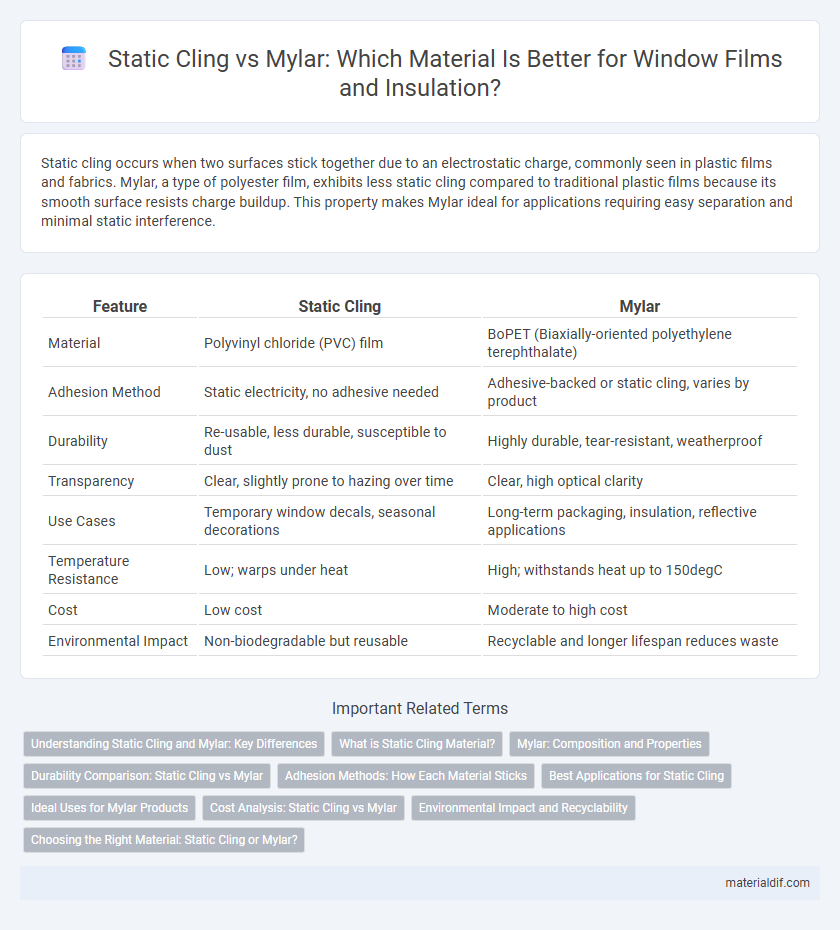Static cling occurs when two surfaces stick together due to an electrostatic charge, commonly seen in plastic films and fabrics. Mylar, a type of polyester film, exhibits less static cling compared to traditional plastic films because its smooth surface resists charge buildup. This property makes Mylar ideal for applications requiring easy separation and minimal static interference.
Table of Comparison
| Feature | Static Cling | Mylar |
|---|---|---|
| Material | Polyvinyl chloride (PVC) film | BoPET (Biaxially-oriented polyethylene terephthalate) |
| Adhesion Method | Static electricity, no adhesive needed | Adhesive-backed or static cling, varies by product |
| Durability | Re-usable, less durable, susceptible to dust | Highly durable, tear-resistant, weatherproof |
| Transparency | Clear, slightly prone to hazing over time | Clear, high optical clarity |
| Use Cases | Temporary window decals, seasonal decorations | Long-term packaging, insulation, reflective applications |
| Temperature Resistance | Low; warps under heat | High; withstands heat up to 150degC |
| Cost | Low cost | Moderate to high cost |
| Environmental Impact | Non-biodegradable but reusable | Recyclable and longer lifespan reduces waste |
Understanding Static Cling and Mylar: Key Differences
Static cling relies on electrostatic forces to temporarily adhere lightweight materials without adhesive, often causing issues with dust attraction and repositioning. Mylar, a polyester film known for its durability, moisture resistance, and ability to create airtight seals, does not depend on static electricity but rather on its physical and chemical properties. Understanding these differences highlights Mylar's suitability for long-term preservation and packaging, while static cling excels in temporary applications like window films and protective covers.
What is Static Cling Material?
Static cling material is a type of vinyl film designed to adhere to smooth surfaces through static electricity rather than adhesive, allowing for easy application and removal without residue. It's commonly used for temporary window graphics, decals, and protective films due to its repositionable nature. Unlike Mylar, which is a durable polyester film known for strength and heat resistance, static cling offers flexibility and convenience for short-term uses.
Mylar: Composition and Properties
Mylar is a polyester film primarily composed of biaxially-oriented polyethylene terephthalate (BoPET), which provides exceptional strength, durability, and chemical stability. Its unique properties include high tensile strength, excellent dimensional stability, and resistance to moisture, gases, and ultraviolet light, making it ideal for packaging, insulation, and reflective applications. Unlike static cling films that rely on electrostatic attraction, Mylar's performance is based on its engineered molecular structure, offering enhanced longevity and thermal resistance.
Durability Comparison: Static Cling vs Mylar
Mylar exhibits superior durability compared to static cling films due to its high tensile strength and resistance to tearing, punctures, and environmental factors like moisture and UV exposure. Unlike static cling, which can lose adherence or degrade over time under harsh conditions, Mylar maintains its structural integrity and protective properties for extended periods. This resilience makes Mylar a preferred choice for applications requiring long-lasting, robust material performance.
Adhesion Methods: How Each Material Sticks
Static cling adheres to surfaces using electrostatic forces generated by friction, enabling temporary attachment without adhesives or residue. Mylar, a polyester film, relies on pressure-sensitive adhesives or heat sealing to bond securely to substrates, providing durable and long-lasting adhesion. The choice between static cling and Mylar depends on the desired permanence and surface compatibility of the application.
Best Applications for Static Cling
Static cling is ideal for temporary decorations, window decals, and promotional signage due to its easy repositioning and residue-free removal. Unlike Mylar, which offers high durability and moisture resistance, static cling excels in applications requiring frequent changes without adhesive damage. Its best use cases include rental spaces, seasonal window graphics, and short-term advertising displays where flexibility and surface protection are priorities.
Ideal Uses for Mylar Products
Mylar excels in applications requiring moisture, gas, and odor barriers due to its metallized polyester composition, making it ideal for food packaging, emergency blankets, and insulation materials. Unlike static cling films that rely on electrostatic properties for temporary adhesion to smooth surfaces, Mylar offers durable, long-lasting protection and thermal insulation. Its resistance to temperature extremes and punctures enhances its functionality in aerospace, electronics shielding, and decorative foil uses.
Cost Analysis: Static Cling vs Mylar
Static cling films typically cost less than Mylar due to cheaper raw materials and simpler manufacturing processes. Mylar offers superior durability and clarity but comes at a higher price point, making it more suitable for long-term applications despite the initial investment. The cost efficiency of static cling is ideal for temporary uses, while Mylar's value is justified by its enhanced performance and longevity.
Environmental Impact and Recyclability
Mylar, a polyester film, offers better recyclability compared to static cling materials, which are often made from non-recyclable plastics contributing to landfill waste. Static cling films, composed mainly of PVC or similar plastics, pose greater environmental risks due to their limited biodegradability and difficulties in recycling processes. Choosing Mylar reduces ecological footprint by supporting efficient recycling streams and minimizing long-term environmental impact.
Choosing the Right Material: Static Cling or Mylar?
Choosing the right material depends on your specific application needs, as static cling films adhere to surfaces without adhesives and are ideal for temporary, repositionable use on glass and smooth surfaces. Mylar, a polyester film known for its durability, moisture resistance, and excellent printability, suits long-term applications requiring strength and stability. Consider factors such as surface type, intended duration, and environmental exposure when deciding between static cling and Mylar films.
Static Cling vs Mylar Infographic

 materialdif.com
materialdif.com